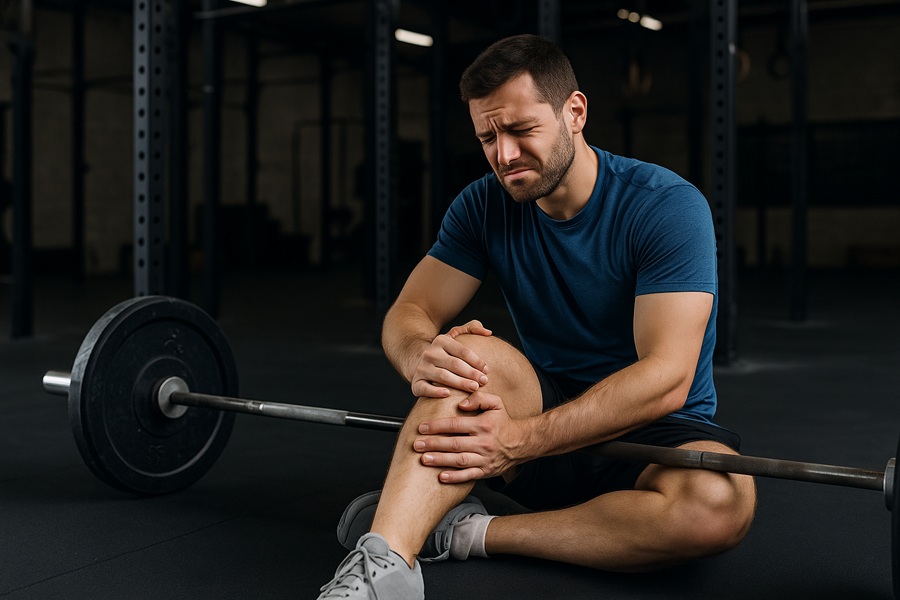Knees Hurt on Leg Day? Don't Skip Your Workout

It’s leg day. You’re under the bar, you take a deep breath, and you begin your descent. Then you feel it - that familiar, unwelcome ache. That sharp pinch. That grinding instability.
If you’ve ever found yourself thinking, "My knees hurt after squats, what i do wrong?" you are far from alone. Knee pain is one of the most common complaints that sends dedicated gym-goers searching for answers. It’s the phantom that haunts leg day, turning your most critical training session into a minefield of potential injury.
But what if that pain wasn't a stop sign, but a signal? A signal that your body is compensating and that it’s time to get smarter, not just stronger. This isn't just about avoiding pain; it's about building resilient, "bulletproof" knees.
Why Do My Knees Hurt While Squatting? (And How to Avoid It)

Let's clear this up immediately: squats are not inherently bad for your knees. Bad squats are bad for your knees. Most of the time, it comes down that post-squat pain is almost always a combination of poor mechanics and muscle imbalances.
- You can run through this quick checklist:
- Are your knees tracking in line with your toes?
- Are your heels staying grounded?
- Are you warming up your glutes and hamstrings?
So, why do knees hurt while squats, and how can we avoid it? The primary issue is often "knee valgus," which is the technical term for your knees caving inward as you push up from the bottom of the squat. This inward collapse places an enormous amount of stress on the ligaments and structures of the knee. This is frequently caused by weak glutes - specifically the gluteus medius - which is responsible for pulling your leg outward and keeping your thigh aligned.
Another major factor is mobility. If you have poor ankle or hip mobility, your body will find a way to hit depth, and it often does so by forcing the knee joint to compensate, placing the stress in the wrong place. To avoid this, you must shift your focus from "lifting the weight" to "moving the body correctly." This means "spreading the floor" with your feet, actively pushing your knees out (in line with your toes), and ensuring you are sitting back into the squat, as if into a chair.
If you’ve been following my articles, you might remember the one where I shared my experience dealing with back pain. The lesson from that still applies here - pain is often the body’s way of asking for better movement, not less of it. If you haven’t read it yet, you can check it out here: myfittrainingplan.com/blog/how-to-relieve-lower-back-pain.
Should I Skip Leg Day If My Knee Hurts?

This brings us to the most pressing question many lifters face. The answer, unless the pain is severe and requires medical attention, is a resounding no.
Skipping leg day is the worst thing you can do for weak or painful knees. Why? Because the reason they hurt in the first place is often weakness and instability. Avoiding training only exacerbates the problem.
The key is to modify, not avoid. You must train around the pain, not through it. This means temporarily shelving the movements that cause that sharp, pinching sensation. It’s time to check your ego at the door, drop the weight, and focus on building the supporting muscles that protect the knee joint.
This means you should probably stop doing certain exercises while you recover and strengthen. You need to avoid high-impact, jarring movements like plyometric box jumps or running. In the weight room, this means staying away from exercises that place maximum shear force on the knee, such as very deep, heavy leg presses, or advanced movements like sissy squats, which put all the load onto the quad tendon and patella. Your goal is to eliminate aggravation while you build a stronger foundation.
What Is the Best Exercise to Strengthen Weak Knees?
If you can't do the big, heavy lifts, what should you be doing? When people ask, "What is the best exercise to strengthen weak knees?" they are often looking for one magic bullet.
The truth is, there isn't one single exercise, but rather a strategy. The strategy is to build the "supporting cast" for your knee: the quadriceps (specifically the VMO, or 'teardrop' muscle), the hamstrings, and the glutes. The best way to do this is through controlled, low-impact isolation exercises.
Instead of heavy back squats, you can shift to movements that build these muscles directly without the instability. A fantastic place to start is with terminal knee extensions (TKEs) using a resistance band. This movement specifically targets that VMO muscle, which is a primary stabilizer for your kneecap. From there, you can progress to light-weight, high-repetition leg extensions on a machine, focusing on a slow, controlled squeeze at the top to build strength and blood flow.
But don't stop at the quads. You must build the muscles that pull as well. Your hamstrings act as the "brakes" for your knee. Incorporating hamstring curls, both seated and lying, is non-negotiable. Furthermore, glute bridges and band-work for your hips (like lateral band walks) will finally build the glute strength you need to keep your knees from caving in when you eventually return to your squat.
Knee pain is not a life sentence; it's a signal. It’s your body telling you to stop, reassess, and build a better, more resilient foundation. Stop chasing the numbers on the bar and start chasing intelligent, pain-free movement. That is how you build knees that last a lifetime.

And please don't forget: after training, give your knees some love - stretch your quads and hip flexors, use a foam roller on your IT band, and apply ice if there’s inflammation. Recovery is where progress happens - i told you about this every time.